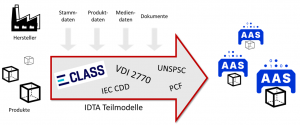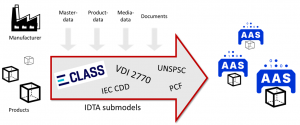Was ist die Verwaltungsschale AAS?
Der Digitale Zwilling in Form der Verwaltungsschale (Asset Administration Shell, AAS) stellt eine virtuelle Repräsentation eines physikalischen Objektes oder Systems dar. Aufbauend auf standardisierten Informationen zum Produkt aus verschiedenen Bereichen können weitere Daten während des Betriebs hinzugefügt werden.
Welche Daten werden für die AAS benötigt?
Die Verwaltungsschale AAS basiert auf der Kombination verschiedener Teilmodelle, die jeweils ein definiertes Thema abbilden. Die Teilmodelle sind durch die IDTA standardisiert. Jedes Teilmodell besitzt dabei spezifische Datenanforderungen, die im Unternehmen aus unterschiedlichen Systemen oder Abteilungen stammen:
- Digital Nameplate
Stammdaten und Zulassungen zum Produkt - Technical Data
Technische Daten mit Klassifikation und Merkmalen nach ECLASS, IEC CDD, UNSPSC, etc. - Handover Documentation
Dokumente zum Produkt klassifiziert nach VDI 2770 - Contact Information
Landesspezifische Unternehmenskontakte - Product Carbon Footprint
Umwelt- und Nachhaltigkeitsaspekte zum Produkt
Die Liste stellt eine Auswahl der wichtigsten und marktüblichen Teilmodelle dar. Insgesamt stehen über die IDTA mehr als 70 Teilmodelle zur Verfügung. Alle Teilmodelle folgen gängigen Daten- und Klassifikationsstandards.
Wie werden die Verwaltungsschalen AAS erzeugt?
Unsere hauseigene Software Class.Room fügt die relevanten Daten für die unterschiedlichen Teilmodelle effizient zusammen. Über entsprechende Schnittstellen werden die Daten aktuell gehalten. Durch einen intelligenten Template-Mechanismus werden die Daten anschließend in die Verwaltungsschalen AAS je Produkt überführt. Das System kann auf unterschiedliche Versionen von Teilmodellen reagieren und unterstützt auch die Mehrsprachigkeit. Datenbereiche wie Klassifikationsattribute können klassenflexibel exportiert werden. Anpassungen und Erweiterungen sind einfach möglich.
Für welche Produkte ist das geeignet?
Der aktuelle Stand der Lösung fokussiert sich auf die Bereitstellung von Verwaltungsschalen AAS durch Hersteller oder Händler, da hier der größte Bedarf besteht. Eine Generierung von AAS aus Sichtweise der Verwender (z.B. Maschinenbau) ist ebenfalls möglich. Mit entsprechenden Ergänzungen können auch konfigurierbare Produkte als Basis genutzt werden, für die beispielsweise die Klassifikationsdaten nach ECLASS erst im Rahmen der Konfiguration ermittelt werden.
Die Software wird auch für die Erzeugung von standardisierten AAS beispielsweise für C-Teile genutzt, die Class.Ing bereitstellen wird.
Ist die Lösung kompatibel zum Digitalen Produktpass 4.0 (DPP 4.0)?
Die Lösung ist kompatibel mit dem aktuellen Stand des Digitalen Produktpasses 4.0. Durch die Mitarbeit von Class.Ing bei IDTA und ECLASS wird die Entwicklung auf dem aktuellen Stand gehalten.
Die wichtigsten Punkte im Überblick
- Erzeugen Sie einfach AAS Modelle für Ihre Produkte!
- Unterstützen Sie die wichtigsten, marktrelevanten Teilmodelle!
- Reagieren Sie flexibel und schnell auf notwendige Änderungen!
- Verwenden Sie eine Standard-Software aus dem Bereich elektronischer Artikeldaten!
- Nutzen Sie Standards von ECLASS und IDTA! Das Institut der Deutschen Wirtschaft empfiehlt einen Digitalen Zwilling / Digitalen Produktpass (DPP) auf Basis von ECLASS und der Verwaltungsschale AAS.
Die Vorteile für Ihr Unternehmen
- Nutzen Sie eine einfache Lösung für die Generierung großer Mengen von Verwaltungsschalen Ihrer Produkte!
- Setzen Sie auf das umfangreiche Wissen von Class.Ing in diesem Bereich!
- Verwenden Sie eine praxiserprobte Lösung!
- Unterstützen Sie Ihre Kunden durch einen weiteren brandaktuellen Medienkanal!
- Seien Sie vorbereitet auf den Digitalen Produktpass 4.0 (DPP 4.0)!
English version
What is the AAS Asset Administration Shell?
The digital twin in the form of the Asset Administration Shell (AAS) is a virtual representation of a physical object or system. Based on standardized information about the product from various areas, additional data can be added during operation.
What data is required for the AAS?
The AAS asset administration shell is based on a combination of different submodels, each of which represents a defined topic. The submodels are standardized by the IDTA. Each submodel has specific data requirements that originate from different systems or departments within the company:
- Digital Nameplate
Master data and approvals for the product - Technical Data
Technical data with classification and properties according to ECLASS, IEC CDD, UNSPSC, etc. - Handover Documentation
Product documents classified according to
VDI 2770 - Contact Information
Country-specific company contacts - Product Carbon Footprint
Environmental and sustainability aspects of the product
The list represents a selection of the most important and commercially available submodels. In total, more than 70 submodels are available via the IDTA. All submodels follow common data and classification standards.
How are the AAS administration shells created?
Our in-house Class.Room software efficiently compiles the relevant data for the various submodels. The data is kept up to date via appropriate interfaces. An intelligent template mechanism is then used to transfer the data to the asset administration shells for each product. The system can react to different versions of submodels and also supports multilingualism. Data areas such as classification attributes can be exported in a class-flexible manner. Customizations and extensions are easily possible.
Which products is this suitable for?
The current status of the solution focuses on the provision of asset administration shells from manufacturers or dealers, as this is where the greatest demand exists. It is also possible to generate AAS from the user’s perspective (e.g. machine builders). With appropriate additions, configurable products can also be used as a basis, for which, for example, the classification data according to ECLASS is only determined during configuration. The software Class.Room is also used to generate standardized AAS for C-parts, for example, which Class.Ing will provide.
Is the solution compatible with the Digital Product Passport 4.0 (DPP 4.0)?
The solution is compatible with the current status of the Digital Product Passport 4.0. Class.Ing’s collaboration with IDTA and ECLASS ensures that development is kept up to date.
The most important points at a glance
- Simply create AAS models for your products!
- Support the most important, market-relevant submodels!
- React flexibly and quickly to necessary changes!
- Use standard software from the field of electronic article data!
- Use standards from ECLASS and IDTA! The German Economic Institute recommends a Digital Twin / Digital Product Passport (DPP) based on ECLASS and the AAS administration shell.
The advantages for your company
- Use a simple solution for generating large quantities of asset administration shells for your products!
- Rely on Class.Ing’s extensive knowledge in this area!
- Use a tried and tested solution!
- Support your customers with another up-to-date media channel!
- Be prepared for the Digital Product Passport 4.0 (DPP 4.0)!


